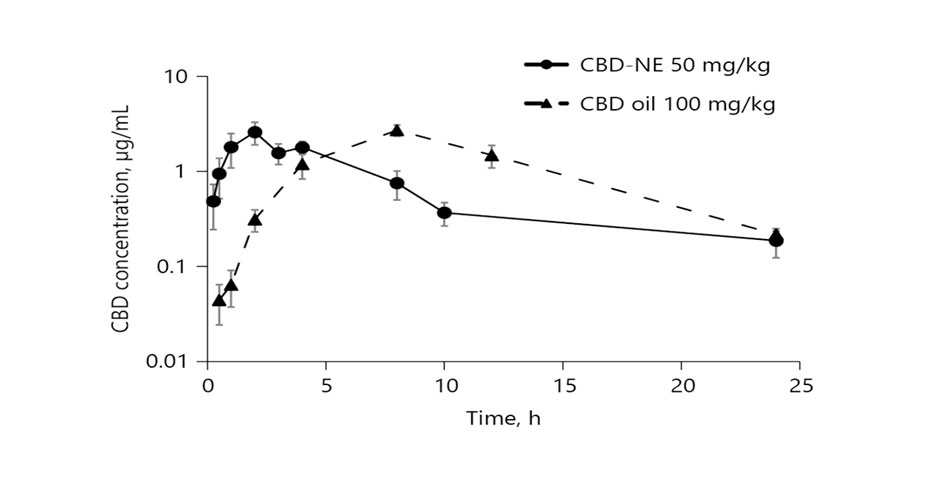Science has made quite the quantum leap recently.
Well, science is always making progress. But recently a certain technology from the scientific world is changing the way we view CBD.
That technology is called nano-emulsion, or nano-emulsification . . . and it’s the focus of this article. Nanoemulsions make CBD more powerful, more bioavailable, and faster-acting. Keep reading to learn more.
What Does “Nanoemulsion” Even Mean?
First, here’s the scientific definition:
“Nanoemulsions are nano-sized emulsions, which are manufactured for improving the delivery of active pharmaceutical ingredients.”
An emulsion is simply a mixture of normally-unmixable substances (think oil+vinegar salad dressing), whose droplets are unusually small in size. Other emulsified substances include milk and mayonnaise. Just keep in mind these are regular emulsions, not nano ones.
Nanoemulsions are, as the above definition points out, nano-sized, and one of their notable features is that they are thermodynamically stable. This means their structure doesn’t dissipate and break down over time. Unlike the tasty vinaigrette you have to keep stirring again and again, nanoemulsions contain special ingredients called surfactants which make them completely shelf-stable.
What Is CBD Nanoemulsion?
CBD nanoemulsion is similarly straightforward. It’s a process where CBD oil is nanoemulsified, or dispersed throughout nano-sized droplets.
The thing that makes nanoemulsions work so effectively for pharmaceuticals is their size. Since nanoemulsified CBD droplets are radically smaller than ‘normal’ CBD droplets, they’re able to permeate hard-to-reach areas of the body and brain.
CBD nanoemulsions also have a drastically larger surface area. At first, this might seem counterintuitive—we’re dealing with smaller droplets here, after all.
Increased surface area is the name of the game when it comes to efficient biology. Why? Because a higher surface area allows more space for information processing, enzymatic activity, and sending or receiving messages. The human brain has its characteristic folds for this very reason. More surface area = a higher number of neurons = more processing power. Similarly, the surface of the small intestine is nearly 2,700 square feet! More surface area = more absorption = more food processing power.
In a very real sense, nanoemulsified substances mirror nature’s design. When it comes to nano-enhanced CBD, more surface area = more receptor activation = more homeostasis.
Why Is Nanoemulsion Important?
Nanoemulsion’s importance becomes clear when you take a look at how nano CBD oil differs from regular CBD oil.
As great as ‘normal’ CBD is, it has one drawback that’s been especially hard to overcome: its low absorption rates. Most CBD oils out there absorb so slowly that their CBD content gets hogged by the liver.
This isn’t the case with nanoemulsified CBD oil. Good things start to happen fast—the very moment the oil hits your tongue, in fact. And that means no more waiting for CBD to be processed by the liver. Nano CBD is a true sublingual, and it doesn’t need to rely on those inefficient, liver-metabolized pathways.
By quickly absorbing through the mouth’s oromucosal membranes, nano CBD is able to enter the bloodstream within mere seconds.
Benefits of CBD Nanoemulsions

Nano-enhanced CBD has all sorts of important benefits. A 2017 Nanoemulsion study notes some of the more important of these from a scientific perspective . . . below is a paraphrased version:
- Can be used as a substitute for liposomes [1]
- Can improve the bioavailability of active compounds [2]
- Are non-toxic and non-irritating in nature
- Have improved physical stability
- Have a greater surface area, which provides greater absorption
- Can be formulated into a variety of CBD products
- Provides better uptake of oil-soluble supplements
- Helps to solubilize lipophilic compounds
- Helps mask the taste of the emulsified substance(s)
- Requires less energy to digest
There are some very practical upsides, too. All you calorie-counters out there may be glad to hear that nano emulsified CBD oils can actually have water—not oil—as their base. That is, while most CBD oils have to use a carrier oil as their base, nano-enhanced CBD does not. True to the character of all things emulsified, nano CBD mixes with the normally-unmixable, so oil and water do mix . . . at least in this case.
Another benefit: nano-emulsified CBD is hydrophilic, or water-loving. It pairs perfectly with virtually all other liquids, including coffee, tea, and adult beverages. Enjoy bulletproof coffee? Nano CBD might just make it even better.
How Is Nanoemulsified CBD Made?
Nanoemulsified CBD oil begins like any other CBD oil, as a densely concentrated hemp extract. From that point on, though, its production process begins to differ.
Most ‘normal’ CBD oils are simply heated and blended with a carrier oil. Since everything is fat-soluble, this mixture dissolves together with minimum effort. This approach is easier for suppliers and CBD manufacturers . . . but processing this fatty oil is not easier for your body.
Nanoemulsified CBD’s production process has a few extra steps that serve to make liposomes—the special fat-based droplets in which nano CBD gets ‘wrapped.’ Each liposome, in turn, is made from fatty acids called phospholipids.
Don’t let the fancy name fool you: phospholipids occur throughout nature and, together with the liposomal structures they create, keep their contents protected from the outside world. Thanks to liposomes, nanoemulsified CBD is protected from being broken down, thus allowing its active ingredients to more easily reach important targets such as the brain.
Converting ‘Normal’ CBD to Nano CBD
What enables the evolution of regular CBD to emulsified CBD? Two things: an added fat source and some type of chemical surfactant. Let’s take a look at added fats first.
Many different types of fats can be structured into liposomes, but some are particularly effective for nano CBD. MCT oil (a pro-metabolism derivative of coconuts) makes a great option, as does sunflower lecithin (a natural byproduct of sunflower seeds). Fun fact: sunflower lecithin is also a powerful brain food.
Surfactants are the other thing that makes nanoemulsification possible.
How to Find Premium Nanoemulsified CBD
Not all nano CBD is created equal. Some brands formulate their nano CBD with harsh surfactants like propylene glycol, and other brands settle for nano-emulsified preparations that aren’t truly nano in nature. Some so-called “nano CBD” may contain particles up to 5,000 nanometers in size! Compared to the ideal 25nm nanoparticle, they just don’t measure up.
In addition to being truly nano-sized, nanoemulsified CBD oil should also be full spectrum. Clinical studies from the world’s leading cannabis research lab at the Hebrew University of Jerusalem have shown that whole plant CBD is four times more effective than CBD isolate.
Much of this variation seems to be caused by hemp’s terpenes; full spectrum CBD oil contains them, while CBD isolate does not. Regarding the limitations of CBD isolate, Dr. Ethan Russo in his landmark study on the entourage effect observes that “One molecule is unlikely to match the therapeutic and even industrial potential of Cannabis itself as a phytochemical factory.”
More Nano CBD Research
At this point, one might be tempted to think that nano CBD seems too good to be true. Well, as good as it is to be skeptical, it’s even better to listen to what the research says:
- CBD “reached faster after oral administration [ . . . ] in a pro-nanoliposphere formulation” [1]
- “The highly lipophilic nature of cannabinoids means that they are seen as suitable candidates for advanced nanosized drug delivery systems.” [2]
- The [nanoparticle] formulation proposed proved to be a promising carrier for the oral delivery of CB13, a cannabinoid with high therapeutic potential [3]
The Latest Nano CBD Research
A recent study took the aforementioned findings even further. Like any good research does, it started with a problem: “cannabidiol (CBD) is highly lipophilic [fat-loving], and its oral bioavailability is known to be very low in humans.”
To combat this low bioavailability of typical CBD, the researchers “developed a novel nanoemulsion preparation of CBD.” Pitting ‘normal’ CBD oil with an olive oil base against a truly nanoemulsified CBD oil with particle size ~35 nanometers, the study’s researchers tested nano CBD’s effects on rats.
What they found was pretty incredible. 50mg/kg of nanoemulsified CBD was slightly more powerful—and exponentially faster acting—than twice as much regular CBD:

Interestingly enough, the bloodstream CBD concentrations provided by these two formulas crossed around the 5-hour mark, with ‘regular’ CBD oil taking the lead. However, achieving this effect required twice the dosage, and people are generally more concerned about the first 5 hours following CBD ingestion.
Regular CBD is itself impressive in its effects . . . but if you want your CBD oil to really mesh with your biology, consider a nano-emulsified upgrade. Nanoemulsion makes CBD more potent, more powerful, and faster-acting, so if you haven’t already, give it a try! You might be surprised to find that micro-level changes can result in truly macro-level improvements.
To Your Health,
Green Maiden




